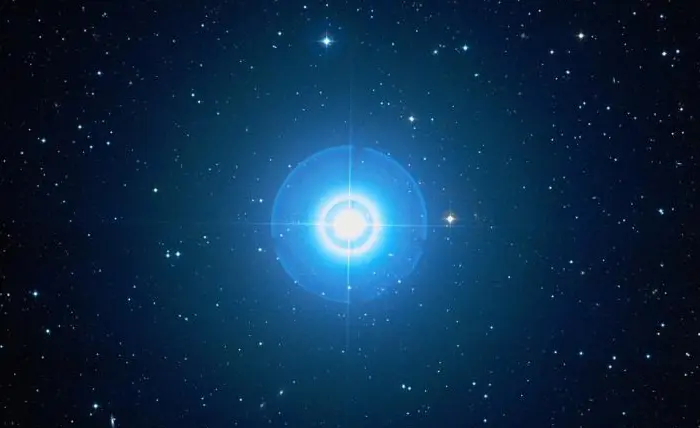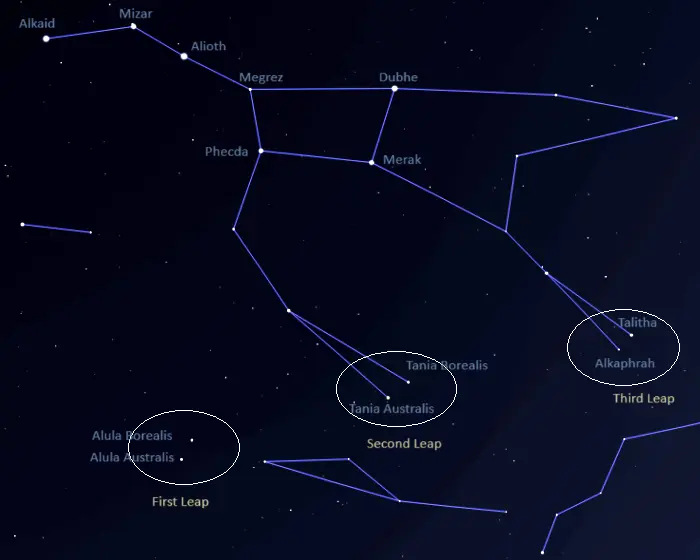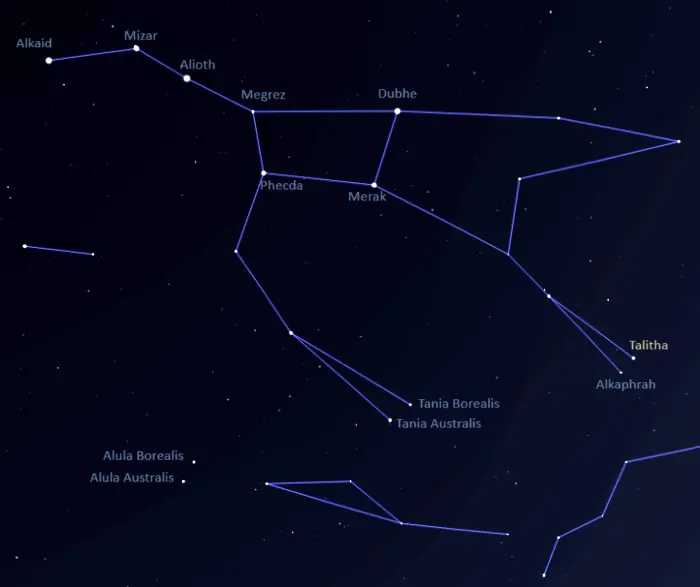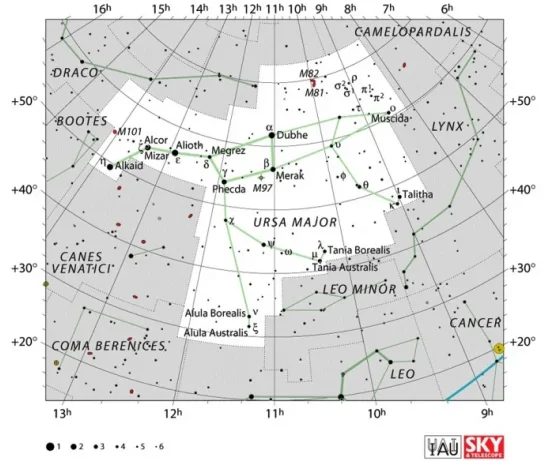Talitha, Iota Ursae Majoris Aa (ι UMa Aa), is the primary component in a multiple star system located 47.3 light-years away in the constellation Ursa Major. With an apparent magnitude of 3.14, it is the ninth brightest star of the Great Bear. The subgiant star is part of an asterism known as Three Leaps of the Gazelle, formed by the stars that mark the Great Bear’s feet.
Star system
Iota Ursae Majoris is a star system consisting of two pairs of binary stars that orbit each other with a period of 2,084 years at a gradually decreasing separation.
The primary component, Iota Ursae Majoris Aa, is part of a spectroscopic binary system (Iota UMa A) with an orbital period of 4,028 days. Formally known as Talitha, the star is classified as a white subgiant of the spectral type A7 IV or F0IV-V. It has a mass of around 1.7 solar masses and an estimated age of 620 million years. With an effective temperature of 7,260 K, it is 9.87 times more luminous than the Sun.
Talitha is a fast spinner. It has a projected rotational velocity of 154 km/s. The star’s spectroscopic companion has not been directly observed, but is believed to be a white dwarf with a mass comparable to that of the Sun.

Talitha (Iota Ursae Majoris), image: Wikisky (DSS)
The other binary system (Iota UMa BC) consists of a pair of red dwarfs of spectral types M3V and M4V. Iota Ursae Majoris B and C have masses of 0.35 and 0.30 solar masses. They have apparent magnitudes of 10.1 and 10.3. The stars are separated by around 0.7 arcseconds, corresponding to a physical separation of at least 10 astronomical units (Earth – Sun distances). They take 39.7 years to complete an orbit around a common centre of mass.
The Iota Ursae Majoris system appears dynamically unstable and may become disrupted in the next 100,000 years. The separation between the components Iota UMa A and Iota UMa B was 10.7 arcseconds (>156 astronomical units) in 1841, when the component B was discovered, and it dramatically decreased to 4.5 arcseconds (>66 AU) by 1971.
Facts
Talitha is one of the six stars that form Three Leaps of the Gazelle, an old Arabic asterism located in the region of the Great Bear’s feet. Talitha and Alkaphrah (Kappa Ursae Majoris) represent the Third Leap, Tania Borealis (Lambda Ursae Majoris) and Tania Australis (Mu Ursae Majoris) the Second Leap, and Alula Borealis (Nu Ursae Majoris) and Alula Australis (Xi Ursae Majoris) the First Leap. In Arabic lore, the three pairs of stars mark the three leaps of a gazelle that was startled by a lion (Leo) and fled across a pond. The names of all the six stars refer to the asterism.
Collectively, the six stars were known as Kafzah al Thiba’, “the Springs of the Gazelle.” They formed the larger gazelle figure with the stars of what is now the constellation Leo Minor. Coma Berenices represented the pond (Al Haud) into which the gazelle leapt.

Three Leaps of the Gazelle, image: Stellarium
Name
The name Talitha (pronunciation: /ˈtælɪθə/) is derived from the Arabic phrase Al Fiḳrah al Thalitha, which was mistranscribed from Al Ḳafzah al Thalitha, meaning “the third leap” or “the third spring (of the gazelle).”
Talitha and its neighbour Alkaphrah (Kappa UMa) were traditionally known as Talitha Borealis and Talitha Australis. The words borealis and australis mean “northern” and “southern” in Latin.
The name Talitha was approved by the International Astronomical Union’s (IAU) Working Group on Star Names (WGSN) on July 20, 2016. It formally applies only to the primary component, Iota Ursae Majoris Aa, but has traditionally been used for the whole star system.
In Chinese astronomy, Talitha was known as 上台一 (Shàng Tái yī), Star of First Upper Step. It forms the Upper Step asterism with Alkaphrah (Kappa Ursae Majoris). The asterism is part of the larger Three Steps asterism, also formed by Tania Borealis (Lambda Ursae Majoris), Tania Australis (Mu Ursae Majoris), Alula Borealis (Nu Ursae Majoris), and Alula Australis (Xi Ursae Majoris). The Three Steps pattern is part of the Supreme Palace Enclosure, which represents the imperial court.
Iota Ursae Majoris was nicknamed Dnoces (“second” backwards) as a joke by Apollo I astronaut Virgil Ivan “Gus” Grissom, after his fellow astronaut Edward H. White II. Grissom also nicknamed Gamma Cassiopeiae Navi (“Ivan” backwards) after himself and Gamma Velorum Regor (“Roger” backwards) after the astronaut Roger Chaffee.
Location
Talitha is very easy to find because it is relatively bright and part of a conspicuous asterism. It forms the third of the Three Leaps of the Gazelle with its neighbour Alkaphrah. The two stars can be found using the bright stars of the Big Dipper. They lie along the imaginary line extended from Alkaid through Phecda or, alternatively, from Megrez through Merak.

Talitha location, image: Stellarium
Constellation
Talitha lies in the constellation Ursa Major. The Great Bear is one of the 48 ancient constellations catalogued by the Greco-Roman astronomer Ptolemy of Alexandria in his Almagest in the 2nd century CE. In Greek mythology, the constellation is associated with the myth of Callisto, a nymph turned into a bear by the goddess Hera.
Ursa Major is the third largest constellation in the sky, after Hydra and Virgo. It stretches across 1,280 square degrees of the northern sky and is the largest northern constellation. From the mid-northern latitudes, it is circumpolar and can be seen throughout the year.
Ursa Major hosts the Big Dipper, one of the most familiar asterisms in the northern celestial hemisphere. The star pattern is formed by some of the constellation’s brightest stars: Alioth, Dubhe, Alkaid, Mizar, Merak, Phecda, and Megrez.

Ursa Major constellation map by IAU and Sky&Telescope magazine
Most of the bright stars in the Great Bear constellation are members of the Ursa Major association, a grouping of stars that formed in the same molecular cloud at about the same time. These stars have similar properties and share a common motion through space.
Notable stars in the constellation include Alioth (Epsilon Ursae Majoris), an A-type giant or subgiant located 82.6 light-years away, the orange giant Dubhe (Alpha Ursae Majoris), the visual double star Mizar (Zeta Ursae Majoris) and Alcor (80 Ursae Majoris), the variable red dwarf Lalande 21185, one of the nearest stars to the Sun, the contact binary system W Ursae Majoris, and the Sun-like yellow dwarf Chalawan (47 Ursae Majoris), which hosts a system of three extrasolar planets.
Ursa Major is home to several well-known deep sky objects. These include the Pinwheel Galaxy (Messier 101), Bode’s Galaxy and the Cigar Galaxy (Messier 81 and Messier 82), the spiral galaxies Messier 108 and Messier 109, and the Owl Nebula (Messier 97), a planetary nebula visible in small telescopes.
The best time of the year to observe the stars and deep sky objects in Ursa Major is during the month of April, when the constellation appears higher above the horizon in the early evening. The entire constellation is visible from locations between the latitudes 90° N and 30° S.
The 10 brightest stars in Ursa Major are Alioth (Epsilon UMa, mag. 1.77), Dubhe (Alpha UMa, mag. 1.79), Alkaid (Eta UMa, mag. 1.86), Mizar (Zeta UMa, mag. 2.04), Merak (Beta UMa, mag. 2.37), Phecda (Gamma UMa, 2.438), Psi Ursae Majoris (mag. 3.01), Tania Australis (Mu UMa, mag. 3.06), Talitha (Iota UMa, mag. 3.14), and Theta Ursae Majoris (mag. 3.166).
Talitha – Iota Ursae Majoris
| Spectral class | F0IV-V or A7 IV + M3V + M4V |
| Variable type | Suspected |
| U-B colour index | +0.08 |
| B-V colour index | +0.19 |
| Apparent magnitude | 3.14/10.1/10.3 |
| Absolute magnitude | +2.31 |
| Distance | 47.3 ± 0.1 light-years (14.51 ± 0.03 parsecs) |
| Parallax | 68.92 ± 0.16 mas |
| Radial velocity | +9.0 ± 2 km/s |
| Proper motion | RA: -441.29 ± 0.17 mas/yr |
| Dec.: -215.32 ± 0.09 mas/yr | |
| Constellation | Ursa Major |
| Right ascension | 08h 59m 12.45362s |
| Declination | +48° 02′ 30.5741″ |
| Names and designations | Talitha, ι Ursae Majoris, Iota UMa, ι UMa, 9 Ursae Majoris, HD 76644, HR 3569, HIP 44127, SAO 42630, FK5 335, BD+48 1707, AG+48 801, GJ 331, IRC +50194, JP11 1734, PPM 50941, PLX 2143, ASCC 325676, PMC 90-93 243, RX J0859.2+4802, TIC 456332840, UBV 8669, UBV M 14950, 2E 2082, 2E 0855.8+4814, WEB 8476, N30 2113, NSV 4329, IRAS 08557+4814, 2MASS J08591246+4802304, WDS J08592+4803A,BC. |
Iota Ursae Majoris A
| Spectral type | F0IV-V or A7 IV |
| Apparent magnitude | 3.14 |
| Parallax | 68.0010 ± 0.4223 mas |
| Radial velocity | +9.0 ± 2 km/s |
| Proper motion | RA: -439.836 ± 0.277 mas/yr |
| Dec.: -214.071 ± 0.338 mas/yr | |
| Mass | 1.7 ± 0.1 M☉ / 1.0 ± 0.3 M☉ |
| Luminosity | 9.87 L☉ |
| Temperature | 7,260 ± 70 K |
| Age | 620 million years |
| Rotational velocity | 154 km/s |
| Surface gravity | 4.30 ± 0.07 cgs |
| Names and designations | ι Ursae Majoris A, Iota UMa A, ι UMa A, 9 Ursae Majoris A, GCRV 5900, LFT 620, LHS 2084, LTT 12347, NLTT 20650, LSPM J0859+4802A, TYC 3420-2149-1, Gaia DR2 1014058103756663936, Gaia DR3 1014058103758571520, CCDM J08592+4803A, ADS 7114 A, WDS J08592+4803A |
Iota Ursae Majoris B
| Spectral type | M3V |
| Apparent magnitude | 10.1 |
| Mass | 0.35 ± 0.05 M☉ |
Iota Ursae Majoris C
| Spectral type | M4V |
| Apparent magnitude | 10.3 |
| Mass | 0.30 ± 0.05 M☉ |